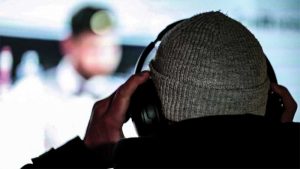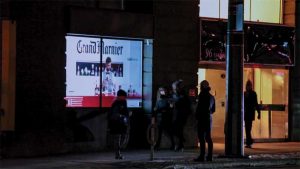How interactive DOOH campaigns are transforming the retail experience
by | 7 August 2020 10:36 am
 [1]
[1]An enticing, immersive digital out-of-home (DOOH) campaign with Campari Canada highlights the steps the group took to refresh the image of the beverage company’s iconic, two-century-old brand, Grand Marnier.
By Nathan Elliott, Elizabeth Crisante Green, and Simón Rojas
It has been 55 years since Simon and Garfunkel’s ‘The Sound of Silence’ topped Billboard magazine’s pop singles chart. While the song’s themes of talking without speaking and hearing without listening are universal, the anthem also provides an aid for understanding the noise surrounding today’s modern cities and the technologies being developed in response.
It is no secret cities are in the midst of a noise epidemic. Between car horns, ambulance sirens, and human exchanges, background noise levels in major urban centres often reach 70 decibels—almost as loud as a vacuum cleaner at close range. The World Health Organization (WHO) has even declared noise pollution as a major public health issue.
Drowning out the noise
As city life gets increasingly louder, urbanites are turning to new technologies to drown out the noise. And, so, too, are big brands with their unique street-level marketing and advertising efforts.
On October 30, 2019, Apple launched its much-anticipated AirPods Pro. The release made instant sound waves around the world, with features including immersive audio, multiple ear tips, and most notably, active noise cancellation. By December, they were sold out almost everywhere, just in time for holiday disappointment. With this, the stage was set for a new chapter in communication, namely for brands attempting to capture the attention of consumers, increasingly distracted by their mobile phones and wearable technology.
AirPods Pro sales continue to impress, with analysts predicting more than 100 million units to be sold in 2020 alone. For perspective, according to The Wall Street Journal, so many New Yorkers had dropped their AirPods onto the subway tracks last year the Metropolitan Transportation Authority (MTA) was considering issuing a public service announcement (PSA) to ask commuters not to take them on or off while entering or exiting trains.
Wearables to create new opportunities
Advertisers often talk about how the public is glued to their device screens. In response, recent industry production has mainly focused on creating memorable video content for mobile consumption. One class of device, however, is rarely-to-ever discussed in marketing and advertising channels: wearables.
Wearables are part of a rising technology class and are fundamentally altering the way people interact with machines and, at the same time, with one another. They are also creating new opportunities for companies in digital out-of-home (DOOH) and retail that are looking—and listening—for change.
 [2]
[2]Much of the group’s current research and development work is focused on seamlessly connecting their digital window-front inventory to passersby using wearable devices to create one-on-one interactions, where the video and audio experience are one and the same.
Transforming windows into immersive and interactive installations
Many companies are recognizing the importance of wearable technology in transforming today’s retail experience.
Canadian-based DOOH media-delivery platform FrontRunner Technologies and Derooted Immersive, a Toronto-based 3D projections and brand experiences design firm, have partnered to align with leading brands, agencies, and real estate companies to transform the windows of empty retail spaces into immersive, interactive installations in cities like Toronto and New York. The technology allows dynamic projection-mapped content to be delivered in real-time, which brings windows to life with art, film, news, sports, music, and advertisements. An illumination flare system drives high-definition and interactive content into window fronts, thereby bringing light to dark spaces. For example, malls need to be seen as vibrant places to attract visitors, so when a store closes, the technology is able to provide an illuminated front, rather than a dark window. That said, the projection systems also brighten up existing retail outlets.
Much of the group’s current research and development work is focused on seamlessly connecting their digital window-front inventory to passersby using wearable devices to create one-on-one interactions, where the video and audio experience are one and the same. Whether it is listening to podcasts, music, or videos in their social feeds, taking calls, or cancelling out the surrounding street noise—Bluetooth, wired headphones, and other wearables have become the must-have digital accessories for many. By recognizing this early on, the companies were able to create a new way of attracting consumer attention without the need of a third-party app or download. The technology elevates DOOH campaigns with high-definition video and then synchronizes it with audio, thereby allowing consumers to further engage with the experience—an augmented reality for public spaces.
Campari Canada for Grand Mariner
An enticing, immersive DOOH campaign with Campari Canada highlights the steps the group took to refresh the image of the beverage company’s iconic, two-century-old brand, Grand Marnier.
 [3]
[3]Accessed by a Quick Response (QR) code or near-field communication (NFC) chip via mobile device, consumers walking by the display were able to connect by simply holding their phone up to the illumination flare and accepting the prompts to receive a link to the full video, binaural sounds, and more information.
The binaural audio campaign invited passersby to “stop for a drink” at several virtual window-front bars in Toronto. Accessed by a Quick Response (QR) code or near-field communication (NFC) via a mobile device, consumers walking by the display were able to connect by simply holding their phone up to the illumination flare and accepting the prompts to receive a link to the full video, binaural sounds, and more information.
Binaural simply means listening with both ears. Described as “virtual reality for the ears,” binaural sounds bring digital window fronts to life with multiple elements that allow listeners to immerse themselves in the content and experience every sound as they would in the real set-up.
As part of the campaign, sounds such as the pop of a bottle, the crisp sizzle of champagne bubbles, and the crackle of breaking ice were shared with window-front bar patrons using wearable devices. Listeners not only experienced the sights, but also the sounds, of a Grand Marnier drink being poured especially for them, interacting with a street-level advertisement unlike ever before.
 [4]
[4]The binaural audio campaign invited passersby to “stop for a drink” at several virtual window-front bars in Toronto.
This was one of the defining features of the campaign. It was conceptualized as a NFC and binaural audio project first. That said, an estimated 1.4 billion smartphones already have NFC chips, so the timing made sense. This marked a turning point for binaural audio technology now being ready for commercialization.
This approach to transforming DOOH shows promise on three fronts:
1. By connecting to mobile devices, the content does not add to any existing street noise.
2. Both audio and visual cues are almost perfectly synchronized, allowing passersby to tune-in to window-front content in real-time.
The team struggled with this integration for months, until stumbling upon an often-overlooked, old-school solution: the past often holds the answers to future hurdles. Now, two streamlined microphones capture
the subtle differences in timing, volume, and timbre that occur as sounds from different directions reach each ear.
3. The window-to-mobile connection allows audiences to take their impression with them, creating brand opportunities for retargeting, redirecting, couponing, and more.
Advertising experiences can create lasting impressions
Now, headlong into a new decade, both retail and DOOH are in the midst of rapid transformations. Wearable devices made to both turn on and off the outside world make for exponential engagement opportunities for brands looking to capture the attention of consumers in new and exciting ways. The most successful media projects moving forward will not only captivate the senses, but also respect the public’s right to connect on its own terms.
Nathan Elliott is the CEO and founder of FrontRunner Technologies, a Canadian-based digital out-of-home (DOOH) media-delivery platform. Projecting the future of content delivery, Elliott and his team deploy immersive digital content and technology in premier WindowFronts across North America. He can be reached via email at nelliott@frontrunner-tech.com[5].
Elizabeth Crisante Green is the director of business development for FrontRunner Technologies, a Canadian-based digital out-of-home (DOOH) media-delivery platform. A leader in the new age of DOOH advertising, Green and her team bring cutting-edge immersive technologies and programmatic opportunities to the advertising and commercial real estate worlds to drive the future of content delivery. She can be reached via email at ecrisante@frontrunner-tech.com[6].
Simón Rojas is the creative director, artist, and co-founder at Derooted Immersive, a Toronto-based 3D projections and brand experiences design firm. With more than 20 years of experience in the design and advertising industries, his hands-on, concept-driven approach has put the company at the top list when it comes to memorable innovations that resonate with clients and participants alike. He can be reached via email at simon@derooted.com[7].
- [Image]: https://www.signmedia.ca/wp-content/uploads/2020/08/Grand_Marnier_Stills_4.jpg
- [Image]: https://www.signmedia.ca/wp-content/uploads/2020/08/Grand_Marnier_Stills_7.jpg
- [Image]: https://www.signmedia.ca/wp-content/uploads/2020/08/Grand_Marnier_Stills_6.jpg
- [Image]: https://www.signmedia.ca/wp-content/uploads/2020/08/Grand_Marnier_Stills_8.jpg
- nelliott@frontrunner-tech.com: mailto:nelliott@frontrunner-tech.com
- ecrisante@frontrunner-tech.com: mailto:ecrisante@frontrunner-tech.com
- simon@derooted.com: mailto:simon@derooted.com
Source URL: https://www.signmedia.ca/how-interactive-dooh-campaigns-are-transforming-the-retail-experience/